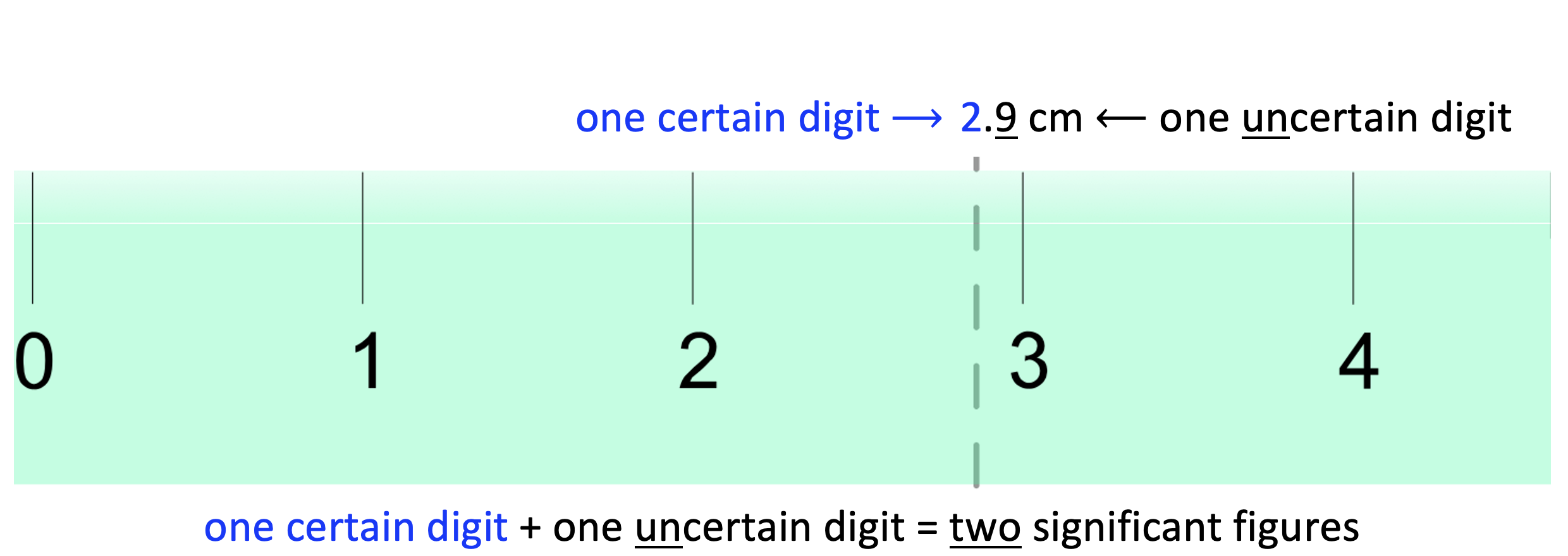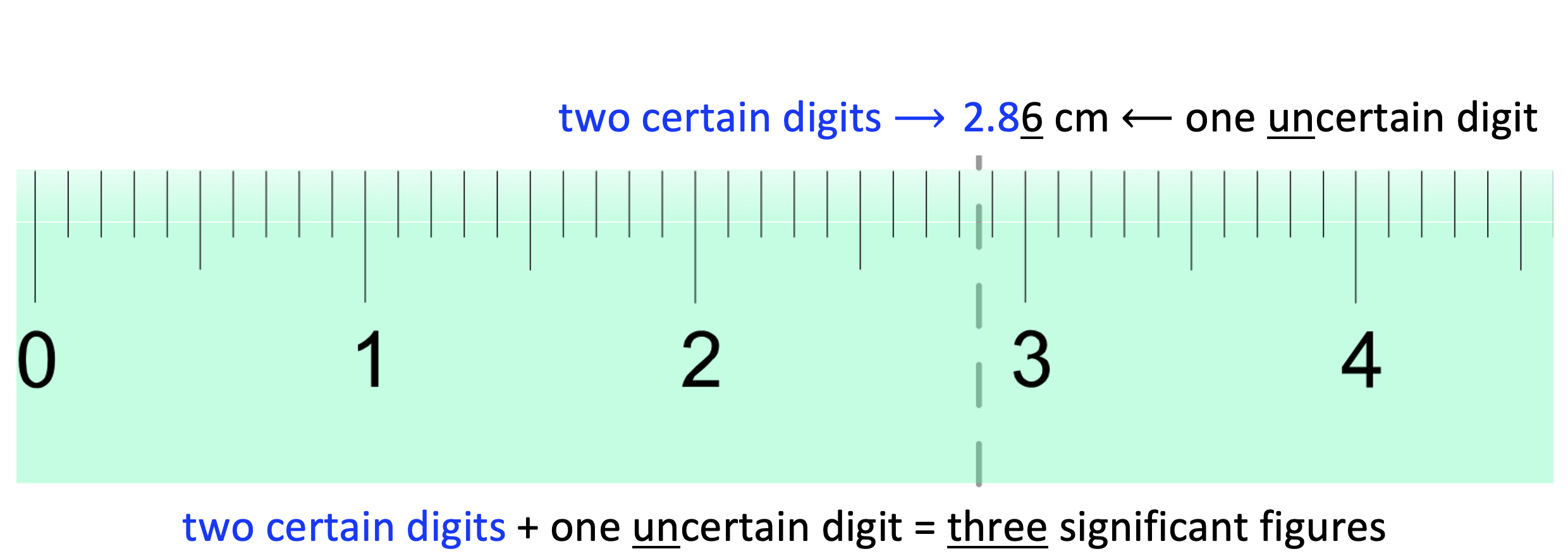2.3: Significant Figures
- Page ID
- 289338
\( \newcommand{\vecs}[1]{\overset { \scriptstyle \rightharpoonup} {\mathbf{#1}} } \)
\( \newcommand{\vecd}[1]{\overset{-\!-\!\rightharpoonup}{\vphantom{a}\smash {#1}}} \)
\( \newcommand{\dsum}{\displaystyle\sum\limits} \)
\( \newcommand{\dint}{\displaystyle\int\limits} \)
\( \newcommand{\dlim}{\displaystyle\lim\limits} \)
\( \newcommand{\id}{\mathrm{id}}\) \( \newcommand{\Span}{\mathrm{span}}\)
( \newcommand{\kernel}{\mathrm{null}\,}\) \( \newcommand{\range}{\mathrm{range}\,}\)
\( \newcommand{\RealPart}{\mathrm{Re}}\) \( \newcommand{\ImaginaryPart}{\mathrm{Im}}\)
\( \newcommand{\Argument}{\mathrm{Arg}}\) \( \newcommand{\norm}[1]{\| #1 \|}\)
\( \newcommand{\inner}[2]{\langle #1, #2 \rangle}\)
\( \newcommand{\Span}{\mathrm{span}}\)
\( \newcommand{\id}{\mathrm{id}}\)
\( \newcommand{\Span}{\mathrm{span}}\)
\( \newcommand{\kernel}{\mathrm{null}\,}\)
\( \newcommand{\range}{\mathrm{range}\,}\)
\( \newcommand{\RealPart}{\mathrm{Re}}\)
\( \newcommand{\ImaginaryPart}{\mathrm{Im}}\)
\( \newcommand{\Argument}{\mathrm{Arg}}\)
\( \newcommand{\norm}[1]{\| #1 \|}\)
\( \newcommand{\inner}[2]{\langle #1, #2 \rangle}\)
\( \newcommand{\Span}{\mathrm{span}}\) \( \newcommand{\AA}{\unicode[.8,0]{x212B}}\)
\( \newcommand{\vectorA}[1]{\vec{#1}} % arrow\)
\( \newcommand{\vectorAt}[1]{\vec{\text{#1}}} % arrow\)
\( \newcommand{\vectorB}[1]{\overset { \scriptstyle \rightharpoonup} {\mathbf{#1}} } \)
\( \newcommand{\vectorC}[1]{\textbf{#1}} \)
\( \newcommand{\vectorD}[1]{\overrightarrow{#1}} \)
\( \newcommand{\vectorDt}[1]{\overrightarrow{\text{#1}}} \)
\( \newcommand{\vectE}[1]{\overset{-\!-\!\rightharpoonup}{\vphantom{a}\smash{\mathbf {#1}}}} \)
\( \newcommand{\vecs}[1]{\overset { \scriptstyle \rightharpoonup} {\mathbf{#1}} } \)
\( \newcommand{\vecd}[1]{\overset{-\!-\!\rightharpoonup}{\vphantom{a}\smash {#1}}} \)
\(\newcommand{\avec}{\mathbf a}\) \(\newcommand{\bvec}{\mathbf b}\) \(\newcommand{\cvec}{\mathbf c}\) \(\newcommand{\dvec}{\mathbf d}\) \(\newcommand{\dtil}{\widetilde{\mathbf d}}\) \(\newcommand{\evec}{\mathbf e}\) \(\newcommand{\fvec}{\mathbf f}\) \(\newcommand{\nvec}{\mathbf n}\) \(\newcommand{\pvec}{\mathbf p}\) \(\newcommand{\qvec}{\mathbf q}\) \(\newcommand{\svec}{\mathbf s}\) \(\newcommand{\tvec}{\mathbf t}\) \(\newcommand{\uvec}{\mathbf u}\) \(\newcommand{\vvec}{\mathbf v}\) \(\newcommand{\wvec}{\mathbf w}\) \(\newcommand{\xvec}{\mathbf x}\) \(\newcommand{\yvec}{\mathbf y}\) \(\newcommand{\zvec}{\mathbf z}\) \(\newcommand{\rvec}{\mathbf r}\) \(\newcommand{\mvec}{\mathbf m}\) \(\newcommand{\zerovec}{\mathbf 0}\) \(\newcommand{\onevec}{\mathbf 1}\) \(\newcommand{\real}{\mathbb R}\) \(\newcommand{\twovec}[2]{\left[\begin{array}{r}#1 \\ #2 \end{array}\right]}\) \(\newcommand{\ctwovec}[2]{\left[\begin{array}{c}#1 \\ #2 \end{array}\right]}\) \(\newcommand{\threevec}[3]{\left[\begin{array}{r}#1 \\ #2 \\ #3 \end{array}\right]}\) \(\newcommand{\cthreevec}[3]{\left[\begin{array}{c}#1 \\ #2 \\ #3 \end{array}\right]}\) \(\newcommand{\fourvec}[4]{\left[\begin{array}{r}#1 \\ #2 \\ #3 \\ #4 \end{array}\right]}\) \(\newcommand{\cfourvec}[4]{\left[\begin{array}{c}#1 \\ #2 \\ #3 \\ #4 \end{array}\right]}\) \(\newcommand{\fivevec}[5]{\left[\begin{array}{r}#1 \\ #2 \\ #3 \\ #4 \\ #5 \\ \end{array}\right]}\) \(\newcommand{\cfivevec}[5]{\left[\begin{array}{c}#1 \\ #2 \\ #3 \\ #4 \\ #5 \\ \end{array}\right]}\) \(\newcommand{\mattwo}[4]{\left[\begin{array}{rr}#1 \amp #2 \\ #3 \amp #4 \\ \end{array}\right]}\) \(\newcommand{\laspan}[1]{\text{Span}\{#1\}}\) \(\newcommand{\bcal}{\cal B}\) \(\newcommand{\ccal}{\cal C}\) \(\newcommand{\scal}{\cal S}\) \(\newcommand{\wcal}{\cal W}\) \(\newcommand{\ecal}{\cal E}\) \(\newcommand{\coords}[2]{\left\{#1\right\}_{#2}}\) \(\newcommand{\gray}[1]{\color{gray}{#1}}\) \(\newcommand{\lgray}[1]{\color{lightgray}{#1}}\) \(\newcommand{\rank}{\operatorname{rank}}\) \(\newcommand{\row}{\text{Row}}\) \(\newcommand{\col}{\text{Col}}\) \(\renewcommand{\row}{\text{Row}}\) \(\newcommand{\nul}{\text{Nul}}\) \(\newcommand{\var}{\text{Var}}\) \(\newcommand{\corr}{\text{corr}}\) \(\newcommand{\len}[1]{\left|#1\right|}\) \(\newcommand{\bbar}{\overline{\bvec}}\) \(\newcommand{\bhat}{\widehat{\bvec}}\) \(\newcommand{\bperp}{\bvec^\perp}\) \(\newcommand{\xhat}{\widehat{\xvec}}\) \(\newcommand{\vhat}{\widehat{\vvec}}\) \(\newcommand{\uhat}{\widehat{\uvec}}\) \(\newcommand{\what}{\widehat{\wvec}}\) \(\newcommand{\Sighat}{\widehat{\Sigma}}\) \(\newcommand{\lt}{<}\) \(\newcommand{\gt}{>}\) \(\newcommand{\amp}{&}\) \(\definecolor{fillinmathshade}{gray}{0.9}\)⚙️ Learning Objectives
- Identify the number of significant figures in a reported value.
After a bank robbery has been committed, police will ask witnesses to describe the thieves. They will usually get an answer such as "medium height". Others may say "between 5 foot 8 inches and 5 foot 10 inches". In each case, there is some level of uncertainty about the height of the criminals.
Measurement Uncertainty
Error or uncertainty exists in almost all measurements. The amount of uncertainty depends both upon the skill of the measurer and upon the quality of the measuring tool. While some balances are capable of measuring masses only to the nearest ±0.1 g, other highly sensitive balances are capable of measuring to the nearest ±0.0001 g or even better. Many measuring tools such as rulers and graduated cylinders have small lines which need to be carefully read in order to make a measurement. Figure \(\PageIndex{1}\) shows two rulers making the same measurement of an object (indicated by the dotted line).
With either ruler, it is clear that the length of the object is between 2 and 3 cm – closer to 3 cm than 2 cm. With the first ruler, the tenths digit may be estimated and the length reported as 2.9 cm. However, another person may judge that the measurement is 2.8 cm. While the 2 is known for certain, the value of the tenths digit is uncertain.
The second ruler has additional markings that represent tenths of a centimeter. Now the same object may be measured as 2.86 cm. The measurer is capable of estimating the hundredths digit because she can be certain that the tenths digit is an 8. Again, another measurer may report the length to be 2.85 cm or 2.87 cm. In this case, there are two certain digits (the 2 and the 8), with the hundredths digit being uncertain. Clearly, the second ruler is a superior choice for measuring lengths, since it is more precise.
Significant Figures
The significant figures in a measurement consist of all the certain digits in that measurement plus one uncertain or estimated digit. In the ruler illustration above, the first ruler yielded a length showing 2 significant figures, while the second ruler yielded a length showing 3 significant figures. In a correctly reported measurement, the final digit is significant but not certain. Insignificant digits are not reported. With either ruler, it would not be possible to report the length as 2.857 cm, since there is no possible way that the thousandths digit could be estimated. The 7 is not significant and would not be reported.
⚡️ Significant Figures
All of the certain digits in a measurement plus one digit that is uncertain.
✅ Example \(\PageIndex{1}\)
Use each diagram to report a measurement to the proper number of significant figures.
A. 
B. 
Solutions
| Explanation | Answer | |
|---|---|---|
| A. | The arrow is between 30 and 40 psi, so the measurement is greater than 30 psi. The arrow appears a little less than one-half of the way across the space between 30 and 40, so the ones place may be estimated as 4. The measurement is reported to two significant figures. |
34 psi |
| B. | The meniscus (lowest level of the liquid) is between 30 and 40 mL, so the measurement is greater than 30 mL. It also appears to be between the second and third small tick marks, so it’s at least 32 mL, but less than 33 mL. Since the meniscus appears to be about \(\textstyle\frac45\) of the distance above the second tick mark, the tenths place may be estimated as 8. The measurement is reported to three significant figures. |
32.8 mL |
✏️ Exercise \(\PageIndex{1}\)
What temperature should be reported?

- Answer
- 124.89 °C
Counting Significant Figures
When you look at a reported measurement, it is necessary to be able to count the number of significant figures. The table below details the rules for determining the number of significant figures in a reported measurement. For the examples in the table, assume that the quantities are correctly reported values of a measured quantity.
| Rule | Examples |
|---|---|
|
|
|
|
|
|
|
|
|
|
Exact Numbers
Integers obtained either by counting objects or from definitions are exact numbers, which are considered to have an infinite number of significant figures. For example, if we count four corners in a rectangle, then the number 4 has an infinite number of significant figures (i.e., it represents 4.000…). Similarly, 1 foot is defined to be the same as 12 inches, so the number 12 in the following equation has an infinite number of significant figures:
\[74.5\cancel{\;\mathrm{inches}}\;\times\frac{1\;\mathrm{foot}}{12\;\cancel{\mathrm{inches}}}=6.21\;\mathrm{feet}\]
✅ Example \(\PageIndex{2}\)
Give the number of significant figures in each measurement.
- 5.87 km
- 0.031 g
- 52.90 ms
- 0.00210 L
- 800 pounds
- 5 fingers
Solution
| Explanation | Answer | |
|---|---|---|
| A | All three digits are significant. | 5.87 km has three significant figures. |
| B | The leading zeros are not significant. The 3 and the 1 are significant. | 0.031 g has two significant figures. |
| C | The 5, 2, and 9 are significant. The trailing zero is also significant. | 52.90 ms has four significant figures. |
| D | The leading zeros are not significant. The 2 and the 1 are significant. The trailing zero is also significant. | 0.00210 L has three significant figures. |
| E | The trailing zeros may or may not be significant. The number could have one, two, or three significant figures. | 800 pounds has an ambiguous number of significant figures. |
| F | 5 is a counting number in this instance. A counting number is an exact number. | 5 fingers has an infinite number of significant figures in this instance. |
✏️ Exercise \(\PageIndex{2}\)
Give the number of significant figures in each measurement.
- 60.0500 m
- 0.00326 s
- 246.3 kg
- 3.5×1012
- 24 students in a lab
- 3800 g
- Answer A
- 6 significant figures
- Answer B
- 3 significant figures
- Answer C
- 4 significant figures
- Answer D
- 2 significant figures
- Answer E
- infinite (exact number)
- Answer F
- Ambiguous, could be two, three or four significant figures.
Accuracy and Precision
Measurements may be accurate, meaning that the measured value is close to the true or known value. They may be precise, meaning that multiple measurements result in nearly identical values (i.e., they are reproducible). They may be both accurate and precise, or they may be neither accurate nor precise. The goal of scientists is to obtain measured values that are both accurate and precise. The video below demonstrates the concepts of accuracy and precision.
✏️ Exercise \(\PageIndex{3}\)
The following archery targets show marks that represent the results of four sets of measurements.

Which target shows
- a precise, but inaccurate set of measurements?
- a set of measurements that is both precise and accurate?
- a set of measurements that is neither precise nor accurate?
- Answer 1
- Target B is precise, but inaccurate.
- Answer 2
- Target D is both precise and accurate.
- Answer 3
- Target A is neither precise nor accurate.
Summary
- Uncertainty exists in all measurements. The degree of uncertainty is affected in part by the quality of the measuring tool.
- Significant figures give an indication of the certainty of a measurement. Rules allow decisions to be made about how many digits to use in any given situation.
This page is shared under a CK-12 license and was authored, remixed, and/or curated by Lance S. Lund (Anoka-Ramsey Community College), Melissa Alviar-Agnew, Henry Agnew, and Sridhar Budhi. Original source: https://www.ck12.org/c/chemistry/.





